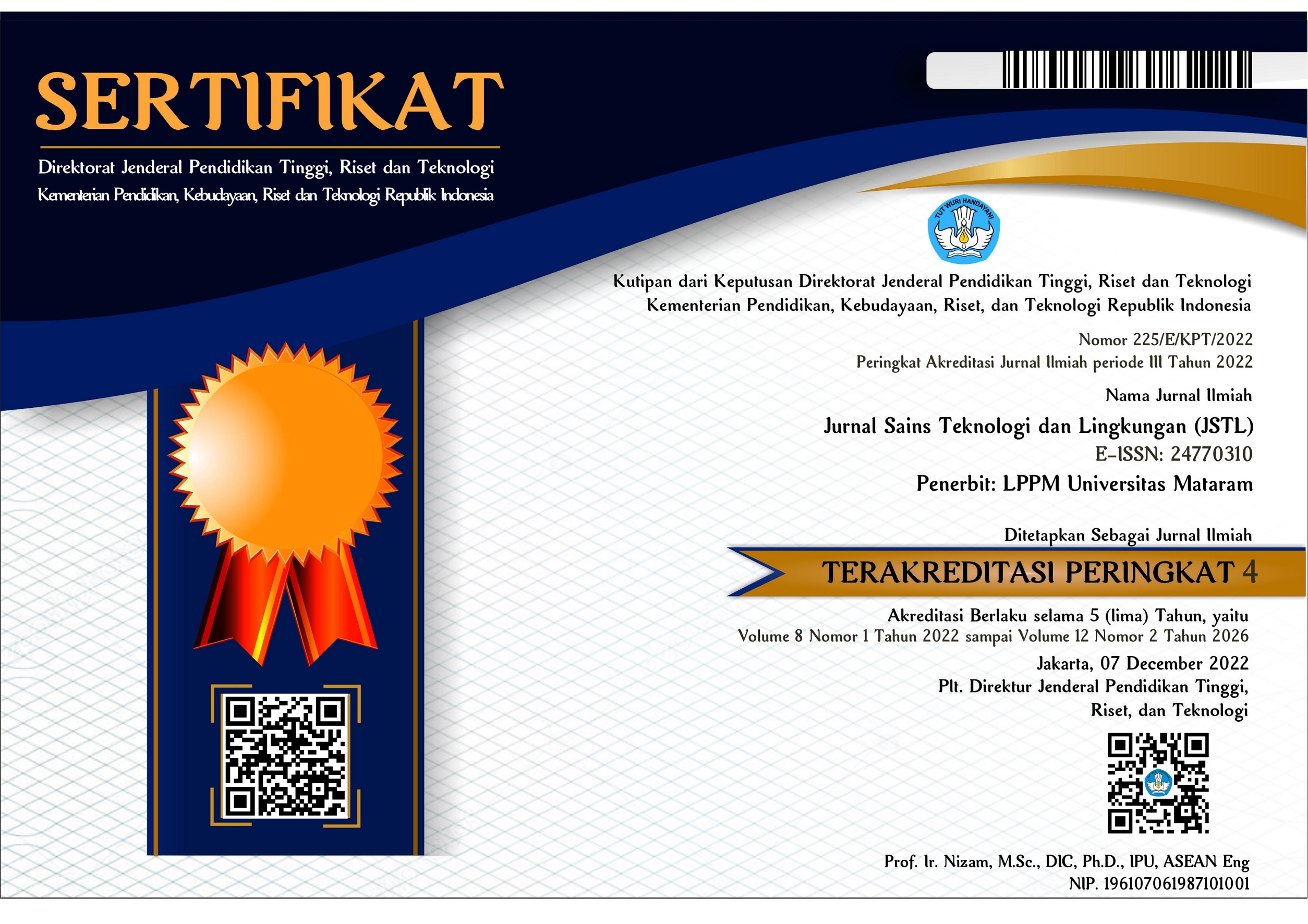Rancang Bangun dan Uji Eksperimental Performa Burner Biomassa Berbahan Bakar Limbah Nyamplung (Calophyllum Inophyllum) dan Pelet Kayu
DOI:
https://doi.org/10.29303/jstl.v11i1.702Keywords:
burner, biomass, nyamplung kernel cake, wood pellets, thermal efficiencyAbstract
As a tropical country, Indonesia has abundant biomass potential because plants grow all year. Among the several types of biomass, nyamplung kernel cake (NKC) has a high potential for use as an energy source. The goal of this research was to develop a biomass burner and evaluate its performance using NKC and wood pellets (WP) as comparisons. The burner performance test is designed to investigate the effect of air mass flow rate on combustion flame, heat release rate, and thermal efficiency for both types of biomass. The thermal efficiency of the burner was calculated using the water boiling test (WBT). The results revealed that using NKC resulted in a longer combustion flame at air flow rates of 146 and 219 g/s. The higher the air flow rate, the longer the flame. The combustion of NKC and WP produced the longest flame, measuring 80 cm with an air mass flow rate of 290 g/s. The experiment also demonstrated that WP produced a higher temperature than NKC. The highest combustion temperature was produced by WP, reaching 818.1°C with an air mass flow rate of 290 g/s. From the two types of biomass evaluated, WP combustion produced more heat than NKC. The highest heat release rate of 35.46 kW was achieved with an air mass flow rate of 290 g/s. The burning of NKC resulted in the maximum thermal efficiency, 30.35% at an air mass flow rate of 219 g/.References
Călin, C., Ion, I. V., Rusu, E., & Frătiţa, M. 2021. Performance analysis of a RDF gasification and solar thermal energy based CCHP system. Energy Reports, 7, 186–192. https://doi.org/10.1016/j.egyr.2021.06.032
Chen, C., Qu, B., Wang, W., Wang, W., Ji, G., & Li, A. 2021. Rice husk and rice straw torrefaction: Properties and pyrolysis kinetics of raw and torrefied biomass. Environmental Technology and Innovation, 24. https://doi.org/10.1016/j.eti.2021.101872
Desalegn, B., Gebeyehu, D., & Tamirat, B. 2022. Wind energy conversion technologies and engineering approaches to enhancing wind power generation: A review. Heliyon, 8(11), e11263. https://doi.org/10.1016/j.heliyon.2022.e11263
Devitra, F. A., Syuriadi, A., & Nuriskasari, I. 2022. Analisis Nilai Kalor pada Bio-Oil Jenis Biomassa Limbah Kotoran Hewan dan Limbah Pressan Biji Nyamplung Hasil Pirolisis. Prosiding Seminar Nasional Teknik Mesin Politeknik Negeri Jakarta, 1283–1289. http://prosiding.pnj.ac.id.
Irbah, Y. N., Nufus, T. H., & Hidayati, N. 2022. Analisis Nilai Kalori dan Laju Pembakaran Briket Campuran Cangkang Nyamplung dan Tempurung Kelapa. Prosiding Seminar Nasional Teknik Mesin Politeknik Negeri Jakarta, 689–694. http://prosiding.pnj.ac.id
Jain, T., & Sheth, P. N. 2019. Design of energy utilization test for a biomass cook stove: Formulation of an optimum air flow recipe. Energy, 166, 1097–1105. https://doi.org/10.1016/j.energy.2018.10.180
Lund, J. W., & Toth, A. N. 2021. Direct utilization of geothermal energy 2020 worldwide review. Geothermics, 90, 101915. https://doi.org/https://doi.org/10.1016/j.geothermics.2020.101915
Manatura, K. 2020. Inert torrefaction of sugarcane bagasse to improve its fuel properties. Case Studies in Thermal Engineering, 19(December 2019), 100623. https://doi.org/10.1016/j.csite.2020.100623.
Nurhadi, N., Kornarius, Y. P., Handoko, S., K. Sirait, J., & Azhar Lutfi, M. 2023. Gasification Burner Performance Test Using Bio-Coal Fuel. Jurnal Indonesia Sosial Teknologi, 4(12), 2333–2423. https://doi.org/10.59141/jist.v4i12.826
Pambudi, P., Widodo, S., & Suharno, K. 2019. Pengaruh Variasi Jumlah Lubang Udara Terhadap Efisiensi Kompor Biomassa. Jurnal Mer-C, 2(1), 1–7. https://jom.untidar.ac.id/index.php/merc/article/view/468
Downloads
Published
Issue
Section
License

This work is licensed under a Creative Commons Attribution-NonCommercial-ShareAlike 4.0 International License.


1.png)











